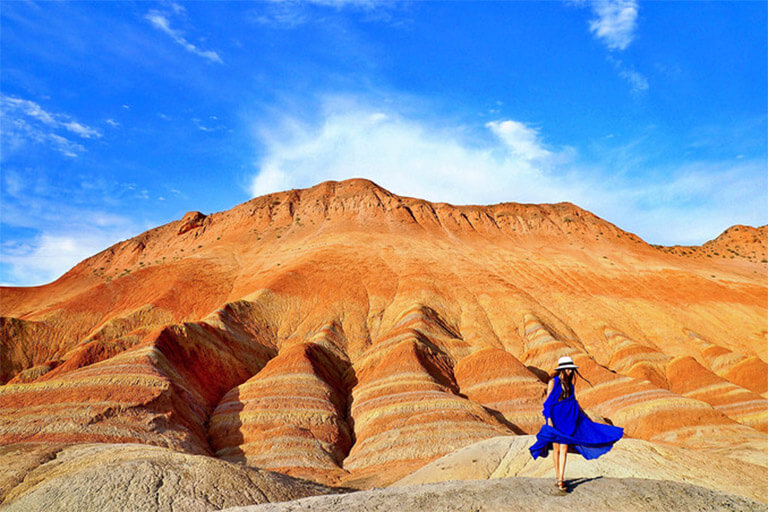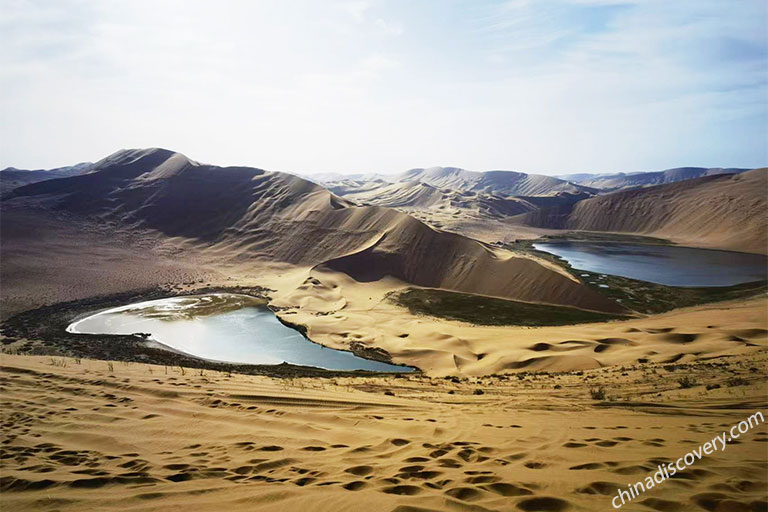Badain Jaran Desert Trekking Tips
Physical demands & age advice
Desert trekking demands strong physical energy and willpower. One usually needs to trek about 15~20km, approximately 5~8 hours each day. If you are interested in desert hiking, you should be fitted enough, keep exercising before your trek, or attend some training if you haven’t had any desert camping experience. Desert camping is not recommended for travelers who have hypertension, heart disease, cerebral hemorrhage, coronary heart disease, etc., and who are aged over 60 years old.
What services/costs are included in your tour?
Our desert tour including services of tour planning and organizing, trekking guide, accommodation (camping/guesthouse), porters, camels for porting and riding (based on your group size), meals (usually breakfast+dinner, or breakfast+lunch, based on actual itinerary), national park ticket, environment protection fee, etc.
What gears are provided?
Tent, moisture-proof pad, sleeping bag (you can bring your own), luggage bags,
Shared gears
Cooking gears, tables, light, interphone, first-aid packet, etc.
What is Badain Jaran Desert weather like?
The Badain Jaran Desert has a temperate continental desert climate, with extremely arid climate and scarce precipitation. The annual average temperature is 7-8℃ (absolute maximum temperature is 37-41℃ / absolute minimum temperature is -37~-30℃). The highest temperature can reach 38-43℃ in July and August. The temperature of the sand surface is 70~80℃. Sunlight and UV is strong. The annual average wind speed is 4 meters per second.
Clothing advice
Bring outdoor windproof, sandproof, and quick-drying clothes; bring sunblock items like sunglasses (goggles),
sunhat, sunscreen, headscarves, masks, to reduce skin exposure, and remember to cover your neck. In the morning and evening, wear a light warm coat, or down jacket and take off at noon.
Shoes advice
Wear high-top climbing shoes or desert boots when crossing the desert on foot and bring a sandproof shoe cover.
Recommended packing list
Large backpack 60L, small backpack 20-30L, rain cover, jacket, 3 quick-drying clothes, 2 quick-drying pants, 2 T-shirts, fleece pants, 2 sets of sweat-wicking underwear, high-top mountaineering shoes or desert boots, slippers or beach shoes, snow cover, 3 pairs of coolmax socks, headband, gloves, hat, sunglasses, goggles, camera, camera battery 2-4, memory card, knife, toilet paper, trekking pole, towel, soap, toothbrush, razor, water container, lifeguard whistle, notebook, pen, headlight, flashlight, mobile phone, watch, money, bank card, food bag, chopsticks, spoon, water cup, charger (mobile phone, camera battery), transparent glue, rubber rope, lipstick, personal medicine.
What to eat and drink during your trek?
During your desert trek, you usually have breakfast and dinner at the camping site, and bring some snacks to eat during your trek. Our chef or tour guide will cook breakfast and dinner for you. Breakfasts are usually bread, instant noodles, with hot water. Dinners are provided with vegetable, rice, meats, and fruits. You can tell us your food requirement beforehand so that our support team can prepare accordingly.
You should pack some snacks with you for everyday trek, such as trail mix, nuts, seeds, nut-based bars, dried or freeze-dried fruits and veggies, energy bars, chews or gels, shelf-stable, dried jerky, such as poultry, salmon or meat jerky, etc. All these snacks should be easy-to-carry and ready-to-eat.
It’s essential to stay hydrated. The camp site will provide boiled water. You can bring 1 big or two small water bottles to collect them. Before hiking, you are suggested to drink 3~4 cups of water, so you have less to carry.

